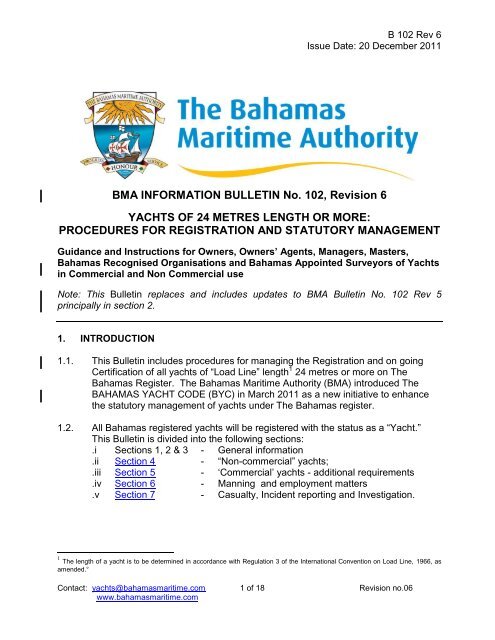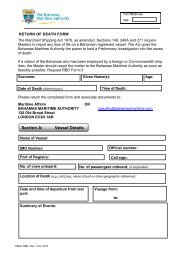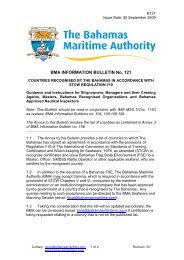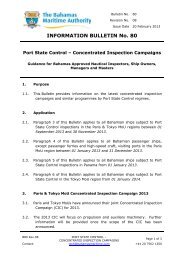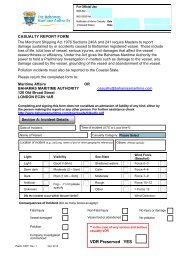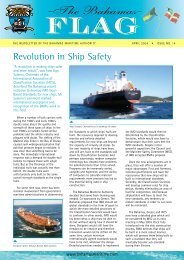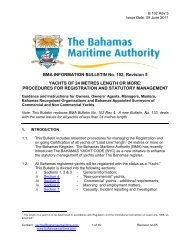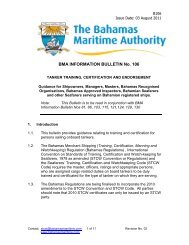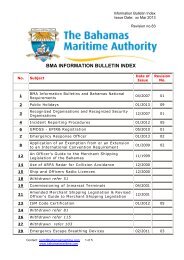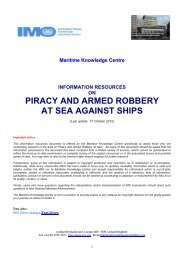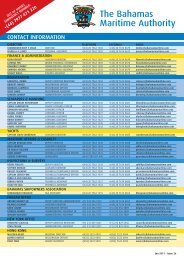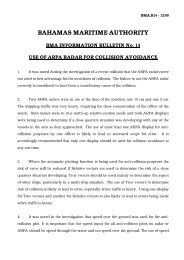BMA Bulletin 102 - The Bahamas Maritime Authority
BMA Bulletin 102 - The Bahamas Maritime Authority
BMA Bulletin 102 - The Bahamas Maritime Authority
Create successful ePaper yourself
Turn your PDF publications into a flip-book with our unique Google optimized e-Paper software.
B <strong>102</strong> Rev 6Issue Date: 20 December 2011<strong>BMA</strong> INFORMATION BULLETIN No. <strong>102</strong>, Revision 6YACHTS OF 24 METRES LENGTH OR MORE:PROCEDURES FOR REGISTRATION AND STATUTORY MANAGEMENTGuidance and Instructions for Owners, Owners’ Agents, Managers, Masters,<strong>Bahamas</strong> Recognised Organisations and <strong>Bahamas</strong> Appointed Surveyors of Yachtsin Commercial and Non Commercial useNote: This <strong>Bulletin</strong> replaces and includes updates to <strong>BMA</strong> <strong>Bulletin</strong> No. <strong>102</strong> Rev 5principally in section 2.1. INTRODUCTION1.1. This <strong>Bulletin</strong> includes procedures for managing the Registration and on goingCertification of all yachts of “Load Line” length 1 24 metres or more on <strong>The</strong><strong>Bahamas</strong> Register. <strong>The</strong> <strong>Bahamas</strong> <strong>Maritime</strong> <strong>Authority</strong> (<strong>BMA</strong>) introduced <strong>The</strong>BAHAMAS YACHT CODE (BYC) in March 2011 as a new initiative to enhancethe statutory management of yachts under <strong>The</strong> <strong>Bahamas</strong> register.1.2. All <strong>Bahamas</strong> registered yachts will be registered with the status as a “Yacht.”This <strong>Bulletin</strong> is divided into the following sections:.i Sections 1, 2 & 3 - General information.ii Section 4 - “Non-commercial” yachts;.iii Section 5 - ‘Commercial’ yachts - additional requirements.iv Section 6 - Manning and employment matters.v Section 7 - Casualty, Incident reporting and Investigation.1 <strong>The</strong> length of a yacht is to be determined in accordance with Regulation 3 of the International Convention on Load Line, 1966, asamended.°Contact: yachts@bahamasmaritime.com 1 of 18 Revision no.06www.bahamasmaritime.com
B <strong>102</strong> Rev 6Issue Date: 20 December 20111.3. <strong>The</strong> BAHAMAS YACHT CODE (BYC) has been written to provide the necessarynational technical standards to ensure that <strong>Bahamas</strong> registered LargeCommercial Yachts continue to meet current international standards. It has beendrafted from the base principles of the United Kingdom Large Yacht Code (LY2)but with a view to the special circumstances of <strong>The</strong> <strong>Bahamas</strong>.1.4. <strong>The</strong> transitional arrangements in section 5.4 of this <strong>Bulletin</strong> will be applied toexisting yachts that have previously complied with <strong>The</strong> <strong>Bahamas</strong> policy asdetailed in earlier versions of this <strong>Bulletin</strong>, including compliance with LY2. <strong>The</strong>process will provide a reasonable transition into the provisions of this <strong>Bulletin</strong> thatare not anticipated to materially affect the management of such yachts.1.5. Yachts are not permitted to carry more than 12 passengers (see Annex 1 -Definitions). Yachts that carry more than 12 passengers are regarded aspassenger ships and therefore subject to applicable technical, operational andcertification provisions of the SOLAS Convention 1974, as amended.1.6. Definitions:1.6.1. “Yacht” - A yacht is a vessel that.i does not carry cargo,.ii does not carry fare-paying passengers on pre-defined routes or itinerariesand.iii is intended for sport or pleasure.1.6.2. Each Bahamian yacht will have a user status of either:.i Non-commercial – when a yacht is used as a “pleasure vessel” or.ii Commercial – when it is used for hire, to carry on board a charterer andtheir party.1.6.3. Further definitions are included in Annex 1 to this <strong>Bulletin</strong>.2. OWNERSHIP, CERTIFICATION, STATUS and CRUISING REQUIREMENTS2.1. <strong>The</strong>re are no ownership requirements, limitations or conditions of nationality,residence or company incorporation for yachts of 24 m or more “Load Line”length 2 .2 <strong>The</strong> length of a yacht is to be determined in accordance with Regulation 3 of the International Convention on Load Line, 1966, asamended.°Contact: yachts@bahamasmaritime.com 2 of 18 Revision no.06www.bahamasmaritime.com
B <strong>102</strong> Rev 6Issue Date: 20 December 20112.2 Certificate of Registry2.2.1. <strong>The</strong> Certificate of Registry will not declare the yacht’s use or status.All yachts, once accepted into permanent registry will be provided with a YachtCertificate of Registry with unlimited validity. <strong>The</strong> previous <strong>BMA</strong> policy of issuingan Annual Certificate of Registry for non-commercial yachts is cancelled and anappropriate certificate will be issued after payment of the 2012 fees.2.2.2. Details of initial and annual registration fees may be obtained from the Registraror by reference to <strong>Bulletin</strong> No 81. Links are available on the “Yachts” page of the<strong>BMA</strong> website.2.3. Certification in accordance with use or status2.3.1. Yachts in ‘Non-commercial’ use must maintain the minimum survey andcertification in accordance with the provisions of section 4 of this <strong>Bulletin</strong>.2.3.2. Yachts in ‘Commercial’ use must maintain survey and certification in accordancewith the provisions of section 5 of this <strong>Bulletin</strong>.2.3.3. If an owner plans to change usage between ‘Commercial’ and ‘Non-commercial,’in accordance with section 2.5 below, the owner must ensure that the yacht andcrew are properly certificated at all times appropriate to the use or status.2.3.4. Yachts in ‘Commercial’ use for part of a year should be maintained inaccordance with the survey, certification and manning provisions of section 5 ona continuous basis, year on year. Any break in the continuity of such certificationmay require re-survey under the BYC.2.3.5. <strong>The</strong> lists in Annex 2 include certificates required under the BYC and othercertificates required for the size and use of each yacht.2.4. Recording a Yacht’s ‘Commercial’ or ‘Non-commercial’ use and status2.4.1. <strong>The</strong> Declaration of ‘Commercial’ or ‘Non-commercial’ use, signed by theOwner, Manager or Captain, and countersigned by the <strong>BMA</strong>, as detailed insection 2.5 below, should form an attachment to the Certificate of Registryto demonstrate the yacht’s use and status. Yachts in ‘Non-commercial’ use ateach year end are required to re-submit a copy of that declaration at the sametime as the payment of the annual fees for the next year. That will becountersigned by the <strong>BMA</strong> and returned to the yacht.Contact: yachts@bahamasmaritime.com 3 of 18 Revision no.06www.bahamasmaritime.com
B <strong>102</strong> Rev 6Issue Date: 20 December 20112.4.2. Yachts that change use during a calendar year must record such changes in theyacht’s <strong>Bahamas</strong> Official Log Book (OLB) for each period that the yacht is in‘Commercial’ or ‘Non-commercial’ use. <strong>The</strong>se records may be examined by a<strong>Bahamas</strong> Surveyor or officer, and may be shown to attending Port State ControlInspectors as evidence of compliance with this <strong>Bulletin</strong>.2.4.3. <strong>The</strong> record referred to in section 2.4.2 should be entered in the narrative sectionof the OLB and consist of an entry similar to one of the following:.i When commencing “Commercial” use: “At the time and date specified[NAME OF YACHT] commenced Commercial use within the provisions ofsection 5 of <strong>The</strong> <strong>Bahamas</strong> <strong>Bulletin</strong> No <strong>102</strong>.”.ii When commencing in “Non-commercial” use: “At the time and datespecified [NAME OF YACHT] commenced Non-commercial use within theprovisions of section 4 of <strong>The</strong> <strong>Bahamas</strong> <strong>Bulletin</strong> No <strong>102</strong>.”2.5. Recording and changing a Yacht’s “Use” with the <strong>BMA</strong>2.5.1. <strong>The</strong> following facility is intended to enable owners to change the usage of theiryacht between ‘Commercial’ and ‘Non-commercial’ when the yacht is madeexclusively available to the owner, their family or friends as described in section1.6.2 above and Annex I. As such it is not intended to provide the facility to“bounce” between each use for a few days or hours. Each declaration shalltherefore remain valid for a minimum period of about 20 days.2.5.2. In order to maintain valid registration, all yachts have the default status of‘Commercial’. <strong>The</strong>reafter any change of status between ‘Commercial’ and ‘Noncommercial’shall be initiated by the owner, or their representative, submitting theappropriate ‘Declaration of Use’ form Y 301 or Y 302. <strong>The</strong>se forms are now onlyavailable from the <strong>BMA</strong> website or <strong>BMA</strong> Yachts: yachts@bahamasmaritime.comwith instructions to facilitate an optional paperless submission and response.<strong>The</strong> web site contains additional advice to aid this procedure.2.5.3. Any appropriate additional annual fee, in accordance with <strong>Bulletin</strong> No 81, shall bepaid at the time. <strong>The</strong> higher fee will be valid for that year and, once paid is notrefundable in full or in part. <strong>The</strong> fee differential between ‘Commercial’ and ‘Noncommercial’is currently (December 2011) $300 plus 20 cents per net ton. Acopy of the Declaration received by the <strong>BMA</strong> will be signed and returned to theyacht for inclusion in the yacht’s papers as this Administration’sacknowledgement of that use or status.2.5.4. Fees for processing and acknowledging the Forms Y 301 and Y 302 are underreview and will be promulgated under a revision of <strong>Bulletin</strong> No 81.2.6. Geographical imitations of cruising are based upon the yacht design,standards of manufacture, cruising range, anticipated weather, crew numbers andcrew qualification.Contact: yachts@bahamasmaritime.com 4 of 18 Revision no.06www.bahamasmaritime.com
B <strong>102</strong> Rev 6Issue Date: 20 December 20112.7. Change of ownership2.7.1. <strong>The</strong> existing owner shall advise the Registrar where there is a change ofownership and comply with the <strong>BMA</strong>’s change of Yacht Ownership requirements.<strong>The</strong> new owner shall make an appropriate Declaration of Use and comply withthe provisions of this <strong>Bulletin</strong>.3. APPLICATION TO REGISTER A YACHT3.1. When considering registering a yacht with <strong>The</strong> <strong>Bahamas</strong> an owner, or theirdesignated agent or manager, may make a general email enquiry toyachts@bahamasmaritime.com . <strong>The</strong> first formal application should be on theYacht Forms YR <strong>102</strong> and YR 104 sent to that email address or directly to a<strong>Bahamas</strong> Registrar in either Nassau, New York, Hong Kong or London.3.2. Form YR <strong>102</strong> provides the <strong>BMA</strong> with the basic information needed to reserve theproposed name on the Register and commence registration. <strong>The</strong>re is noobligation or firm commitment to register when submitting this form.3.3. In the case of a new construction the owner, or their designated representative,should determine at an early stage the intended operational status of the yachtthroughout the yacht’s life – including after possible re-sale – as this may have adirect bearing on the design and technical requirements.3.4. Owners and their representatives are advised to become familiar with the <strong>BMA</strong>’sweb site - www.bahamasmaritime.com – where all necessary information isavailable, particularly on the <strong>BMA</strong> “Yachts” page. Form YR 101 lists allappropriate Registration Forms that will be needed to complete the registrationprocess.3.5. All yachts will be reviewed by the <strong>BMA</strong> for their compliance with requiredtechnical standards prior to provisional and permanent registration. Deficienciesor issues identified during the review will be advised to the owner who will berequested to rectify them before registration is granted.Contact: yachts@bahamasmaritime.com 5 of 18 Revision no.06www.bahamasmaritime.com
B <strong>102</strong> Rev 6Issue Date: 20 December 20114. YACHTS in NON-COMMERCIAL USE4.1. Survey and Technical Standards4.1.1. <strong>The</strong> technical standards, certificates and surveys required for yachts in Noncommercialuse are described in Appendix 2 and summarised here:.i Carving and Marking (see Annex 2/1.1).ii International Tonnage Certificate (ITC) (see Annex 2/1.2).iii Ship Radio Licence (see Annex 2/1.3).iv MARPOL Convention 73/78, as amended (see Annex 2/1.4) – includingappropriate record books, to demonstrate compliance, as summarised below: MARPOL Annex I (Oil Pollution) including International Oil PollutionPrevention Certificate (IOPPC) and Oil Record Book (see Annex 2/1.4.2) MARPOL Annex IV (Sewage) (see Annex 2/1.4.3) MARPOL Annex V (Garbage) including a Garbage Management Planand Garbage Record Book (see Annex 2/1.4.4) MARPOL Annex VI (Air Pollution) including International Air PollutionPrevention Certificate (IAPPC) (see Annex 2/1.4.5)Engine International Air Pollution Prevention Certificate (EIAPPC) (seeAnnex 2/1.4.6).v International Anti-Fouling System Certificate (IAFSC) (see Annex 2/1.5).vi Bunker Convention Certificate of Civil Liability (Bunker CLC) (see Annex 2/1.6).4.1.2. Annex 2 also contains a simplified table of required statutory surveys andcertificates which may be applicable, according to size and tonnage.4.1.3. Yachts in Non-commercial use are not mandated to comply with the provisions ofthe BYC but section 1.10 of BYC recommends that pleasure vessels do complywith those standards. In particular it is strongly recommended that yachts in‘Non-commercial’ use comply with the LSA and fire fighting sections (13, 14 and15) of the BYC.4.1.4. In addition the owner may wish to undertake periodic survey by the <strong>BMA</strong> to attestto this compliance. <strong>The</strong>re is an increased awareness of the need fordemonstrable compliance with recognised standards for all yachts world wide.Maintaining an agreed programme of survey to such standards is an economicmethod of demonstrating compliance with published standards of the Flag State.4.1.5. As referred to in section 2.3.4, above, owners who require the flexibility to easilychange their yacht’s use between ‘Commercial’ and ‘Non-commercial’ use shouldmaintain compliance with the BYC on a continuous, year on year basis in orderto enable quick and easy transfer of such declared use.4.1.6. <strong>The</strong> transition process from LY2 to BYC is referred to in section 5.4.Contact: yachts@bahamasmaritime.com 6 of 18 Revision no.06www.bahamasmaritime.com
B <strong>102</strong> Rev 6Issue Date: 20 December 20115. YACHTS in COMMERCIAL USE5.1. Survey and Technical Standards5.1.1. Annex 2 lists a general description of those requirements and contains asimplified table of required statutory surveys and certificates which areapplicable, depending upon size and tonnage.5.1.2. Yachts subject to this section shall comply with the technical standards andmandatory provisions for their size and total number of persons on board asfollows:.i <strong>The</strong> same standards and certification as applied to yachts in ‘Noncommercial’use described in section 4.1.1.ii BYC (see 5.3 below and Annex 2/2.2).iii International Load Line Certificate (ILLC) (see Annex 2/2.3).iv <strong>Maritime</strong> Labour Convention (MLC 2006) (see Annex 2/2.4).v Safety Construction Certificate (SAFCON) (see Annex 2/2.5).vi Safety Equipment Certificate (SEC) (see Annex 2/2.6).vii Safety Radio Certificate (SRC) (see Annex 2/2.7).viii LRIT (see Annex 2/2.7.1 & .2).ix International Safety Management Certificate (ISM) (see Annex 2/2.8).x International Ship Security Certificate (ISSC) (see Annex 2/2.9).xi Continuous Synopsis Record (CSR) (see Annex 2/2.10).xii <strong>Bahamas</strong> Safety inspection (see Annex 2/2.11.)5.2. <strong>The</strong> Role of Classification Societies, Recognised Organisations and<strong>Bahamas</strong> Yacht Surveyors5.2.1. All Commercial yachts over 300 GT are required to be “in class” with one of ourRecognised Organisations (RO) (see <strong>Bulletin</strong> No 3).5.2.2. All ROs, as listed in <strong>Bulletin</strong> No 3, are authorised to examine plans, performsurveys and issue statutory certification on behalf of <strong>The</strong> Commonwealth of the<strong>Bahamas</strong>. This authorisation is for all statutory surveys including the BYC butexcludes those in 5.2.5 below.5.2.3. Owners of yachts that use a Classification Society must be aware of their SocietyRules. Some Societies will not undertake statutory surveys unless the yacht issimultaneously maintained “in Class” – under Classification Society Rules.5.2.4. Additionally, some Classification Society rules may only allow them to class andsurvey vessels that are constructed to international standards or their own Rules.Furthermore owners of yachts of less than 300 GT who use an RO must beaware that some Societies will not undertake statutory surveys unless the yachtis simultaneously maintained “in Class.”Contact: yachts@bahamasmaritime.com 7 of 18 Revision no.06www.bahamasmaritime.com
5.2.5. ROs are not authorised to undertake the following:B <strong>102</strong> Rev 6Issue Date: 20 December 2011Carving and Marking Inspections<strong>Bahamas</strong> Annual Inspections (where deemed necessary)Casualty or Incident Investigations.5.2.6. <strong>Bahamas</strong> Appointed Yacht Surveyors are specialist surveyors who are capableof undertaking surveys and audits for statutory surveys, certificates, inspectionsand investigations. <strong>The</strong>ir involvement in the survey process is by appointmentthrough the <strong>BMA</strong>, unless specific directions from the <strong>BMA</strong> authorise differently.5.3. <strong>Bahamas</strong> Yacht Code (BYC)5.3.1. <strong>The</strong> depth and extent of the survey for <strong>The</strong> <strong>Bahamas</strong> Yacht Code (BYC), referredto in ‘5.1.2.ii’ above, will depend upon the tonnage of the yacht and otherstatutory surveys that may be in place which duplicate certain sections of theCode.5.3.2. Some sections of the BYC also modify some aspects of the SOLAS certificatesfor yachts that are over 500 GT. Surveyors engaged on such surveys shall beguided by the specialist provisions of the BYC when surveying for SOLAScompliance.5.4. Transition procedure for existing yachtsYachts that have previously been certificated to LY2, shall adopt the followingtransition process..i For the purpose of survey there is very little difference between theprovisions of the BYC and those of the UK’s Large Yacht Code – LY2. Assuch surveyors will be able to easily survey for BYC compliance for anyyacht that is already compliant with LY2 or was constructed to that or asimilar standard. An uncontrolled version of the BYC is available on thewebsite that shows the principle differences between the two codes..ii.iiiFor an interim period commencing from September 2011, <strong>The</strong> <strong>BMA</strong> willcontinue to recognise an existing certificate, based upon compliance withLY2, issued under pre 2011 <strong>BMA</strong> policy.At the next survey for annual compliance or renewal of LY2 the surveyor willsurvey against the BYC and new certificates will be issued, under thecontinuity of the existing certificate. During this transition period the <strong>BMA</strong>policy will be one of recognition of certification against either LY2 or BYC.Contact: yachts@bahamasmaritime.com 8 of 18 Revision no.06www.bahamasmaritime.com
B <strong>102</strong> Rev 6Issue Date: 20 December 2011.ivOther statutory certificates, where necessarily applicable to the tonnage ofthe Yacht, will continue to be valid as they will have been issued by an ROunder existing agreements that are not altered..v Once all existing yachts are certificated against BYC the ‘Transition’ periodwill cease and a new revision of this <strong>Bulletin</strong> will be issued.5.5. <strong>Bahamas</strong> Safety Inspection5.5.1. Section 28.3.3 of the BYC requires a mandatory attendance of a <strong>Bahamas</strong> yachtsurveyor at least once during the five year period of the BYC Certificate ofCompliance concurrent with the statutory surveys being carried out. <strong>The</strong> schedulefor this inspection will be arranged through the <strong>BMA</strong> Yachts and will be tailored tothe cruising style and location of the yacht. This Inspection cannot be made by aRecognised Organisation surveyor.5.5.2. Owners, or their agents, managers or captains, are encouraged to maintaincommunications with the <strong>BMA</strong> Yachts Section to facilitate this provision and tominimise unnecessary costs.5.5.3. Where a <strong>Bahamas</strong> Yacht Surveyor is appointed to undertake another statutorysurvey the <strong>Bahamas</strong> Safety Inspection may be made simultaneously.6. MANNING– including elements of STCW, ILO and MLC (<strong>Maritime</strong> Labour Convention)6.1. This sub-section, 6.1, applies to all yachts;sub-section 6.2 applies to yachts declared to be in ‘Commercial’ use;sub-section 6.3 applies to yachts declared to be in ‘Non-commercial’ use.6.1.1. <strong>The</strong> principles of safe manning of large yachts are adequately covered in theBYC with details expanded in BYC sections 26.2.2 and .3. <strong>The</strong> introduction ofBYC section 26.2 applies to every vessel under <strong>The</strong> <strong>Bahamas</strong> register, includingevery yacht. It states:<strong>The</strong> <strong>Bahamas</strong> <strong>Maritime</strong> <strong>Authority</strong> requires that all vessels are safely andsufficiently manned in relation to the nature of their operation with theresponsibilities placed on companies owning or operating seagoing vessels,to ensure that their vessels are manned with personnel of appropriategrades who have been properly trained and certificated. <strong>The</strong> numbers ofcertificated officers and certificated and non-certificated ratings must besufficient to ensure safe and efficient operation of the vessel at all times.Contact: yachts@bahamasmaritime.com 9 of 18 Revision no.06www.bahamasmaritime.com
B <strong>102</strong> Rev 6Issue Date: 20 December 2011<strong>The</strong> <strong>BMA</strong> places a duty on the owner and operator to provide the master of avessel with the necessary resources to comply with the manningrequirements.6.1.2. Seafarers working on board Bahamian yachts may apply for and be issued withSeaman’s Record Books (SRB). <strong>The</strong>se are dealt with under <strong>Bulletin</strong> No 107.Please note that a <strong>Bahamas</strong> SRB is NOT an identity document and is unsuitablefor immigration purposes or as an authoritative identity document. Suchdocuments should be issued by the seafarer’s National body.6.2. Yachts in ‘Commercial’ use - Manning6.2.1. ‘Commercial’ yachts must be issued with and carry an original Safe ManningDocument (SMD) under the provisions of SOLAS Ch V/14.2, as amended or, forthose of less than 500 GT, the BYC. <strong>The</strong>y are valid for a period of 5 years andare charged in accordance with the ‘Fee’ <strong>Bulletin</strong> No 81. Please refer to <strong>Bulletin</strong>No 115 (Safe Manning requirements) in making an application and use the formYR 106 in order to ensure that all relevant data is supplied.6.2.2. Officer’s Watchkeeping Certificates under the STCW Convention and similarcertificates for yachts, such as those of the master, deck and engineer officersreferred to in 6.2.3 below, must be Endorsed by the <strong>BMA</strong> in accordance with theprocedures for Flag State Endorsements in regulation I/10 of STCW, asamended, referred to in detail in <strong>Bulletin</strong> No 108, using the Application Form fromthe website, <strong>Bulletin</strong> No 124 and, for fees, in <strong>Bulletin</strong> No 81.6.2.3. Watchkeeping Certificates of lower grades than those detailed in the STCWConvention, as amended, may be recognised by the <strong>BMA</strong> on a case by casebasis. All such endorsements of certificates, under the procedures of <strong>Bulletin</strong>No 108, will be processed under the authorisation of this <strong>Bulletin</strong>.6.2.4. Crew Articles, crew agreements and the social and employment provisions of<strong>The</strong> <strong>Bahamas</strong> Merchant Shipping Act, ILO and, when it becomes effective, MLC(<strong>Maritime</strong> Labour Convention) are mandatory on Commercial yachts.6.3. Yachts in ‘Non-commercial’ use - Manning6.3.1. Manning codes and conventions, including the provisions of MLC, are notmandatory for ‘Non-commercial’ yachts. Owners who wish to voluntarily complywith such should refer to section 6.1 and 6.2 above. <strong>The</strong> BYC recommends thatall yachts are issued with a Safe Manning Document. Please see section 6.2.1.6.3.2. <strong>The</strong> provisions for Seaman’s Record Books and Watchkeeping Certificates,detailed in sections 6.1 & 6.2, are available to crew members on a voluntary basis.Contact: yachts@bahamasmaritime.com 10 of 18 Revision no.06www.bahamasmaritime.com
B <strong>102</strong> Rev 6Issue Date: 20 December 20116.3.3. As referred to in 2.2.4 above owners who require the flexibility to easily changetheir yacht’s use between ‘Commercial’ and ‘Non-commercial’ should considermaintaining compliance with the BYC on a continuous basis including the abovemanning procedures for Commercial yachts, in order to enable quick and easytransfer of declared use from Non-commercial to Commercial.7. INCIDENT, CASUALTY AND ACCIDENT REPORTING7.1. All yachts, of any size or status, must comply with the Incident reportingprocedures detailed in <strong>BMA</strong> <strong>Bulletin</strong> No 4.**********************Contact: yachts@bahamasmaritime.com 11 of 18 Revision no.06www.bahamasmaritime.com
B <strong>102</strong> Rev 6Issue Date: 20 December 2011ANNEX 1Definitions1. A “Guest” on board a non-commercial pleasure vessel is a collective term used todescribe the “immediate family and friends” in the following definitions that havebeen extracted from the BYC.2. A “Pleasure vessel” is:2.1.1. any vessel which at the time it is being used is:i. (aa) in the case of a vessel wholly owned by an individual or individuals,used only for the sport or pleasure of the owner or the immediatefamily or friends of the owner; or(bb)in the case of a vessel owned by a body corporate, used only forsport or pleasure and on which the persons on board are employeesor officers of the body corporate, or their immediate family or friends;andii.on a voyage or excursion which is one for which the owner does not receivemoney for, or in connection with, operating the vessel or carrying anyperson, other than as a contribution to the direct expenses of the operationof the vessel incurred during the voyage or excursion; or2.1.2. any vessel wholly owned by or on behalf of a members' club formed for thepurpose of sport or pleasure which, at the time it is being used, is used only forthe sport or pleasure of members of that club or their immediate family, and forthe use of which any charges levied are paid into club funds and applied for thegeneral use of the club; and2.2. In the case of any vessel referred to in paragraphs 2.1.1 or 2.1.2 above, no otherpayments are made by or on behalf of users of the vessel, other than by theowner.2.3. <strong>The</strong> term "immediate family" in 2.1.1 i (aa), (bb) and 2.1.2 above means anindividual, the husband or wife of the individual, and a relative of the individual orthe individual's husband or wife and a "relative" means brother, sister, ancestoror lineal descendant.Contact: yachts@bahamasmaritime.com 12 of 18 Revision no.06www.bahamasmaritime.com
B <strong>102</strong> Rev 6Issue Date: 20 December 20112.4. A ‘passenger’ means any person carried in a ship or yacht who does not meet thecriteria in 2 above except:i. a person employed or engaged in any capacity on board the ship on thebusiness of the ship or yacht orii. a person on board the ship or yacht either in pursuance of the obligation laidupon the master to carry shipwrecked, distressed or other persons, or byreason of any circumstances that neither the master nor the owner nor thecharterer (if any) could have prevented oriii. a child under one year of age.3. Further amplification of persons employed on board:3.1. “A person employed or engaged in any capacity on board the vessel on thebusiness of the vessel” i.e. crew, includes:iiiiiibona-fide members of the crew over 16 years of age who are properlyemployed by the owner in the operation of the vessel;person(s) employed by the owner in connection with business interests ofthe owner and providing service to passengers or the owner and guests:andperson(s) employed by the owner in relation to social activities on boardand providing a service available to passengers or the owner and guests.3.2. It should be noted that whether a person on board a vessel should be consideredas a ‘passenger’ or as a member of the ‘crew’ is determined by their employmentstatus. Recognising that not all members of the crew are directly employed bythe owner, the term ‘employed by the owner’ maybe elaborated to mean‘employed by the owner, or employed by a Company, who under contract, isrequired to provide the owner with personnel to be engaged on board’.3.3. <strong>The</strong> above persons engaged on the business of the vessel are to be provided withaccommodation that has been approved for the use of crew and, are to beincluded in the crew Articles of Agreement, which is required for the vessel. <strong>The</strong>yare also to be provided with familiarisation and training, appropriate their duties.Contact: yachts@bahamasmaritime.com 13 of 18 Revision no.06www.bahamasmaritime.com
B <strong>102</strong> Rev 6Issue Date: 20 December 2011ANNEX 2STATUTORY SURVEYS AND CERTIFICATES REQUIRED FOR YACHTSGeneral description, Tonnages, etc.1. YACHTS in NON-COMMERCIAL USE1.1. Carving and Marking1.1.1. <strong>The</strong> term “Carving and Marking” covers the ‘permanent’ marking on the hull andstructure of a vessel’s name, port of registry, official number, net tonnage and draftmarks. <strong>The</strong> legislative requirement for this is in the Merchant Shipping Act section 9.1.1.2. Special consideration may be given for the structural material of the yacht.1.1.3. Inspection for Carving and Marking is a requirement at first registration or during theperiod of provisional registration and subsequently for any changes, such as nameor net tonnage.1.2. International Tonnage Certificate (ITC)Applicable to all yachts of 24 m length or over. This is issued at construction orwhen a yacht is altered such that the tonnage is increased or decreased.1.3. A Ship Radio Licence will be issued at the time of registration by the <strong>BMA</strong> on behalfof <strong>The</strong> <strong>Bahamas</strong> Utilities Regulation & Competition <strong>Authority</strong> (URCA), which is theresponsible national communications regulatory body. See the Application formsR 108 and <strong>Bulletin</strong> No 6 (for registration of an EPIRB.)1.4. MARPOL Convention 73/78, as amended1.4.1. All yachts are required to comply with the provisions of the MARPOL Convention73/78 subject to the applicability of each Annex as detailed below. Such surveys, andany periodic inspections from any national or official body, will also require appropriaterecord books to be available on board to demonstrate compliance. Blank books, forMARPOL Annexes I (Oil), V (Garbage) and VI (Air) are available from the <strong>BMA</strong>Publications: publications@bahamasmaritime.com.1.4.2. MARPOL Annex I (Oil Pollution) Control and discharge of any form of petroleum oil International Oil Pollution Prevention Certificate (IOPPC) Oil Record Book (ORB) IOPPC and ORB are both applicable to all yachts of 400 GT or over MARPOL Annex I, Regulations 6, 7 & 8 deal with survey and certification MARPOL Annex I, Regulation 17 deals with recording oil storage andtransfers.Contact: yachts@bahamasmaritime.com 14 of 18 Revision no.06www.bahamasmaritime.com
B <strong>102</strong> Rev 6Issue Date: 20 December 20111.4.3. MARPOL Annex IV (Sewage) Applicable to all yachts of 400 GT and over or less than 400 GT but carryingmore than 15 persons <strong>The</strong> <strong>Bahamas</strong> has not ratified MARPOL Annex IV (Sewage) but theprovisions of this Annex apply to any yacht that visits a port, or sails to orwithin the waters of an IMO Member State that has ratified that Annex Surveyors are authorised to issue a ‘Statement of Compliance’ in lieu of aConvention Certificate.1.4.4. MARPOL Annex V (Garbage) Applicable to all yachts of any size Garbage Management Plan and Garbage Record Book Yachts of 400 GT and over or less than 400 GT but carrying more than 15persons are required under Annex V Regulation 9 to carry a GarbageManagement Plan and to maintain records in a Garbage Record Book <strong>The</strong>re are no survey or certification requirements for this Annex but PortStates and other Inspections will require compliance with applicableprovisions of the Annex. This is best demonstrated by completion andretention of a Garbage Record Book.1.4.5. MARPOL Annex VI (Air Pollution) Applicable to all yachts of any size except as expressly provided in Annex VI International Air Pollution Prevention Certificate (IAPPC) Applicable to yachts of 400 GT or over. (See Annex VI, Regulations 6 & 7) Please see <strong>Bulletin</strong>s Nos 75 and 126 (Annex VI record Book).1.4.6. Engine International Air Pollution Prevention Certificate (EIAPPC) This is required for every diesel engine greater than 130 kW (exceptemergency engines) in yachts that are constructed or that undergo a majorconversion after 01 January 2000 This certificate is usually issued by the engine manufacturer Please again see <strong>Bulletin</strong> No 75, particularly with respect to recentconstructions or new engines.1.5. International Anti-Fouling System Certificate (IAFSC) <strong>The</strong> AFS Convention applies to all registered vessel types operating in themarine environment, without any tonnage limitation Yachts of 400 GT or over engaged on an international voyage must have avalid IAFSC and should be subjected to survey whenever the anti-foulingsystems are changed or replaced. Please see <strong>Bulletin</strong> No 113.1.6. Bunker Convention Certificate of Civil Liability (Bunker CLC) Applicable to all yachts over 1,000 GT and is issued by a <strong>Bahamas</strong> registrarupon evidence of appropriate insurance cover. Please see <strong>Bulletin</strong> No 112.Contact: yachts@bahamasmaritime.com 15 of 18 Revision no.06www.bahamasmaritime.com
B <strong>102</strong> Rev 6Issue Date: 20 December 20112. YACHTS in COMMERCIAL USE2.1. As Section 1 of this Annex plus the following:2.2. <strong>The</strong> <strong>Bahamas</strong> Yacht Code (BYC)2.2.1. Commercial yachts of 24 meters in “Load Line” length or more shall comply with theprovisions of <strong>The</strong> <strong>Bahamas</strong> Yacht Code (BYC). <strong>The</strong> depth and extent of the surveywill depend upon the tonnage of the yacht and other corresponding surveys thatmay be in place which duplicate certain sections of the Code.2.3. International Load Line Certificate (ILLC)Applicable to yachts except those operating under section 4 only.2.4. <strong>Maritime</strong> Labour Convention 2006 (MLC)<strong>The</strong> provisions of this Convention, when it comes into force, will be applicable to allcommercial yachts. <strong>The</strong> current advice from the <strong>BMA</strong> is published and updated asand when necessary through the <strong>BMA</strong> <strong>Bulletin</strong> system. <strong>The</strong> latest advice is availablein <strong>Bulletin</strong> No 127. <strong>The</strong> principal concern for future planning is that of crewaccommodation spaces, under Title 3 of MLC. Discussions between flag states andindustry representatives in formulating a uniform and practical approach to theseare on going. Please contact yachts@bahamasmaritime.com to discuss concernsof Bahamian Yachts.2.5. Safety Construction Certificate (SAFCON)Applicable to yachts of 500 GT or over. <strong>The</strong>re are two distinct parts of SAFCON,both as modified by the BYC:.i Construction - SOLAS Ch II-1 and.ii Structural fire protection and means of escape - SOLAS Ch II-2.2.6. Safety Equipment Certificate (SEC).Applicable to yachts of 500 GT or over. <strong>The</strong>re are three distinct parts of the SEC,as modified by the BYC:.i Fire appliances - SOLAS Ch II-2.ii Life-saving appliances - SOLAS Ch III and.iii Navigation equipment - SOLAS V.Contact: yachts@bahamasmaritime.com 16 of 18 Revision no.06www.bahamasmaritime.com
B <strong>102</strong> Rev 6Issue Date: 20 December 20112.7. Safety Radio Certificate (SRC)Applicable to yachts of 300 GT or over - SOLAS Ch IV, as modified by the BYC,including an LRIT Conformance Test Report if such equipment is fitted.2.7.1. <strong>The</strong> LRIT requirements, as detailed in <strong>Bulletin</strong> No 111, as amended, are applicableto all commercial yachts of 300 GT and above.2.7.2. Such yachts that operate exclusively in a GMDSS A1 sea area and are fitted withAIS are not required to install LRIT. <strong>The</strong>re is a provision for an exemption orequivalent arrangement, as detailed in paragraph 3 of <strong>Bulletin</strong> No 111 if theyengage in an international voyage outside the GMDSS A1 sea area.2.7.3. Neither the Safety Radio Certificate nor the record of equipment for the Safety RadioCertificate should be amended in any way to document compliance with the obligationto transmit LRIT information. <strong>The</strong>se documents can only be amended by the body thatissued them.2.8. International Safety Management Certificate (ISM)Applicable to yachts of 500 GT or over. Yachts of less than 500 GT, in compliancewith the BYC should operate under a Safety Management system that conforms tothe principles of Annex 2 of the BYC. This is not subject to external audit butprovides a tool for a common approach to safety management and recording.2.9. International Ship Security Certificate (ISSC)Applicable to yachts of 500 GT or over.2.10. Continuous Synopsis Record (CSR)Applicable to yachts over 500 GT (SOLAS Ch XI-I Reg 5)Detailed requirements are available in <strong>Bulletin</strong> No 57.2.11. <strong>Bahamas</strong> Safety Inspection2.11.1. Section 28.3.3 of the BYC requires a mandatory attendance of a <strong>Bahamas</strong> yachtsurveyor at least once during the five year period of the BYC Certificate ofCompliance concurrent with the statutory surveys being carried out. <strong>The</strong> schedule forthis inspection will be arranged through the <strong>BMA</strong> Yachts, London office and will betailored to the cruising style and location of the yacht. This Inspection cannot bemade by a Recognised Organisation surveyor.2.11.2. Owners, or their agents, managers or captains, are encouraged to maintaincommunications with the <strong>BMA</strong> Yachts Section to facilitate this provision and tominimise unnecessary costs.2.11.3. Where a <strong>Bahamas</strong> Yacht Surveyor is appointed to undertake another statutorysurvey the <strong>Bahamas</strong> Safety Inspection may be made simultaneously.Contact: yachts@bahamasmaritime.com 17 of 18 Revision no.06www.bahamasmaritime.com
B <strong>102</strong> Rev 6Issue Date: 20 December 2011YACHTS of 24 m or more in lengthStatutory Documents required on board a <strong>Bahamas</strong> Registered YachtCertificate/Document Issuing body 1 NoncommercialCommercialForm Y 301 Declaration of Non-commercial use orOwner & <strong>BMA</strong> (B<strong>102</strong>/2.5.2) (B<strong>102</strong>/2.5.2)Form Y 302 Declaration of Commercial useCarving and Marking Inspection <strong>BMA</strong> (B<strong>102</strong>/4.1.1.i) (B<strong>102</strong>/4.1.1.i)Certificate of Compliance<strong>The</strong> <strong>Bahamas</strong> Yacht Code (BYC) or UK MCA LargeCommercial Yacht Code (LY2) – to phase outRecognisedOrganisations (Class)/ <strong>BMA</strong>- (B<strong>102</strong>/5.1.2.ii)& (B<strong>102</strong>/5.3)International Tonnage Cert. RO / <strong>BMA</strong> (B<strong>102</strong>/4.1.1.ii) (B<strong>102</strong>/4.1.1.ii))International Load Line Cert. RO / <strong>BMA</strong> - (B<strong>102</strong>/5.1.2.iii)Safety Construction Cert. – 500 GT & over RO / <strong>BMA</strong> - (B<strong>102</strong>/5.1.2.v)Safety Equipment Cert. – 500 GT & over RO / <strong>BMA</strong> - (B<strong>102</strong>/5.1.2.vi)Safety Radio Cert. – 300 GT & over RO / <strong>BMA</strong> - (B<strong>102</strong>/5.1.2.vii)LRIT Conformance Test Report <strong>BMA</strong> - (B<strong>102</strong>/5.1.2.viii)Int’l Oil Pollution Prevention Cert. – 400 GT & over RO / <strong>BMA</strong> (B<strong>102</strong>/4.1.1.iv) (B<strong>102</strong>/4.1.1.iv)Doc. of Comp: International Sewage Prevention400 GT and over or carrying more than 15 persons.Garbage Management Plan and Record Book400 GT and over or carrying more than 15 persons.RO / <strong>BMA</strong>Owner (B<strong>102</strong>/4.1.1.iv) (B<strong>102</strong>/4.1.1.iv) 5 (B<strong>102</strong>/4.1.1.iv) 5 (B<strong>102</strong>/4.1.1.iv)Int’l Air Pollution Prevention Cert. – 400 GT & over RO / <strong>BMA</strong> (B<strong>102</strong>/4.1.1.iv) (B<strong>102</strong>/4.1.1.iv)Engine Int’l Air Pollution Prevention Cert. Manufacturer 4 (B<strong>102</strong>/4.1.1.iv) 4 (B<strong>102</strong>/4.1.1.iv)Intl Anti-fouling System Certificate – 400 GT & over RO / <strong>BMA</strong> (B<strong>102</strong>/4.1.1.v) (B<strong>102</strong>/4.1.1.v)Bunker Convention CLC – 1,000 GT & over <strong>BMA</strong> (B<strong>102</strong>/4.1.1.vi) (B<strong>102</strong>/4.1.1.vi)<strong>Maritime</strong> Labour Convention 2006 (MLC) RO / <strong>BMA</strong> - (B<strong>102</strong>/5.1.2 iv)ISM Safety Management Cert – 500 GT & over RO / <strong>BMA</strong> - 2 (B<strong>102</strong>/5.1.2.ix)International Ship Security Cert – 500 GT & over RO / <strong>BMA</strong> - 3 (B<strong>102</strong>/5.1.2.x)Continuous Synopsis Record (CSR) – 500 GT & over <strong>BMA</strong> - (B<strong>102</strong>/5.1.2 xi)<strong>Bahamas</strong> Safety Inspection Certificate <strong>BMA</strong> - (B<strong>102</strong>/5.5)Safe Manning Document <strong>BMA</strong> - (B<strong>102</strong>/6.2.1)Certificate of Registry <strong>BMA</strong> (B<strong>102</strong>/2.2) (B<strong>102</strong>/2.2)Ship Radio Licence <strong>BMA</strong> (B<strong>102</strong>/4.1.1.iii) (B<strong>102</strong>/4.1.1.iii)Notes1. Details of the only Classification Societies that are Recognised Organisations are in <strong>BMA</strong> Information <strong>Bulletin</strong> no. 32. <strong>The</strong> “Company” requires Document of Compliance. See <strong>BMA</strong> Information <strong>Bulletin</strong> no. 233. See <strong>BMA</strong> Information <strong>Bulletin</strong> no. 70 : Ship Security4 Applies to diesel engines > 130 kW in yachts built or having a major conversion after 01 Jan 20005 <strong>The</strong> <strong>Bahamas</strong> has not ratified MARPOL Annex V (Garbage) but the provisions of Annex V applies to any yacht thatvisits a port, or sails to or within the waters of an IMOContact: yachts@bahamasmaritime.com 18 of 18 Revision no.06www.bahamasmaritime.com


